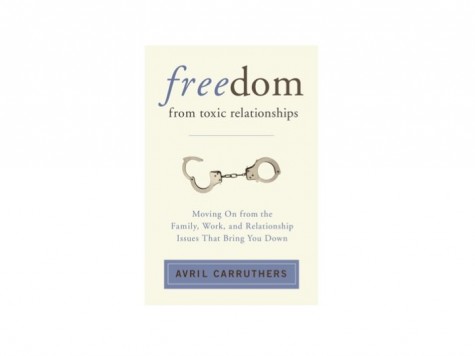By Leslie Chavez
When it comes to our romantic lives, so many of us have been stuck in a toxic environment, trying desperately to escape without success. Enough is enough! Life is way too short to be entangled in poisonous partnerships. Author Avril Carruthers paves the way for lasting love in her new book, Freedom From Toxic Relationships: Moving on from the Family, Work and Relationship Issues that Bring You Down, a guide that explains where these toxic relationships begin and what kind of psychological pain they entail. She teaches her readers how to observe these patterns, making it possible to truly move on. It’s time to leave those destructive relationships behind and start creating more loving and meaningful connections.
You say that our love lives can become toxic without us being aware of it. How can a relationship that began with true love end up filled with anger, fear, and resentment?
Relationships go through phases. We might be aware that the initial “honeymoon” stage is called that for a reason. As the relationship deepens, we trust that our beloved will be kind, but at the same time, we fear that they will see something in us that we don’t like about ourselves. We then project our fear of rejection and make assumptions based on the inevitable baggage we’ve brought with us from previous relationships. We might react with anger or resentment based on what we imagine our partner is thinking or saying. Many relationships flounder at this point, when we cannot perceive past our projected insecurities.
Related Link: How to Kick That Bad Relationship to the Curb
What are some signs that we can look for in order to avoid this from happening? How do we maintain an awareness surrounding any negativity we may be giving off?
A major red flag is whenever we find ourselves having a strong emotional reaction. At that point, we need to take a step back and ask ourselves: Where is this reaction coming from? When might we have felt this before? Sometimes, we can see that our reaction is similar to a time when we were younger. What wisdom and resources do we have now that we had no access to then? How would we prefer to behave instead?
If your partner seems to be the cause of the toxicity — they might be inconsiderate, unreasonable, demanding, or cruel — we need to see how and in what way we might be inadvertently hooked into the dysfunctional dynamic and change what we can. If communicating with them doesn’t work, the best way to handle this situation is to move away, just as you would from a dangerous creature.
Shifting gears, the book explores the concept of “energetic psychic cords.” Can you explain this idea to our readers? How do the cords develop in our relationships? At what point do we need to “clear the cord”?
An energetic tie or psychic cord is a transference of emotion or thoughts that appears to have a life of its own; they occur between people who are in or have been in an intense relationship. We feel the effects of this cord when we find ourselves behaving in ways we wish we’d rather not or getting lost in the other’s emotions or projections.
They sometimes develop to the degree in which we become needy and insecure and have low self-esteem and hold unrealistic expectations based on fantasies. The process of clearing a cord starts with awareness of the dynamic: How does this attachment control or affect us? If we can differentiate between what is the other person’s “stuff” and what is our’s, we may not need a cord clearing. But if it’s an old, engrained cord that’s hard to disentangle, we might need the help of the structured process that culminates in the ritual of a formal cord clearing.
You say that energetic cords can form instantly when people fall in love at first sight. So tell us: Do you believe that love at first sight exists? How can someone distinguish the difference between love and lust in the early stages of a relationship?
In my experience, instant attractions are likely to be chemistry based on physical or emotional appeal. It’s not always lust because we can have a crush on someone when we are six years old with the same intensity as when we fall for that stranger across the room when we are in our twenties. Whether these instant attractions ever develop into something more lasting depends on whether we appreciate them as they truly are or have projected something unrealistic onto them.
If you find it difficult to distinguish between love and lust, try keeping sex out of the equation for a period. Can the relationship be sustained with conversation alone?
Related Link: Five Ways to Stop Sabotaging Your Relationship
And finally, what advice can you give to singles in order to attract a healthy, loving, and positively transforming relationship?
Be in the present; be genuine; appreciate the best in people; and respect yourself as well as others. This is difficult when a relationship represents comfort and familiarity — it’s too easy to do what we’ve always done and not question whether we are being authentic to ourselves and to our partner.
It also helps to know what you want. Work to improve those things in yourself that you believe you want in your partner. This way, you will attract and recognize that person as the one you are looking for. But be discerning and remember that the universe doesn’t only send us what we really want; it tests us to act in our own best interests.
For more information on Carruthers and her new book, click here.



